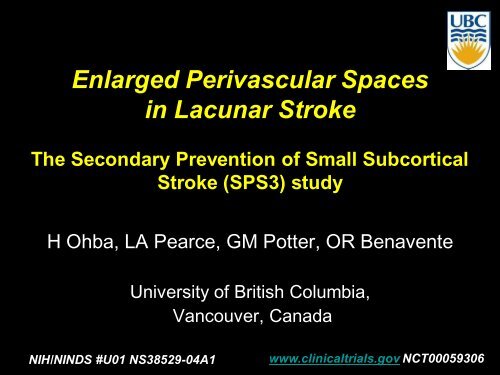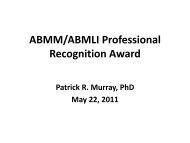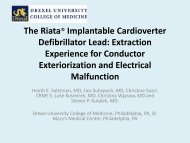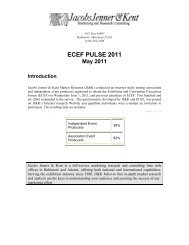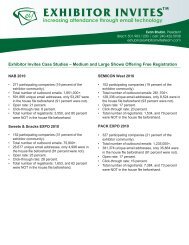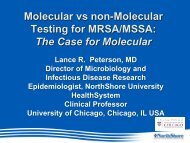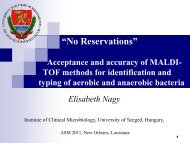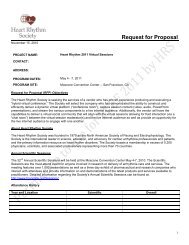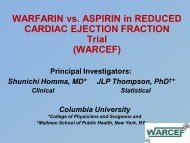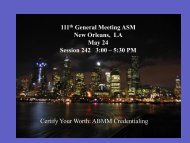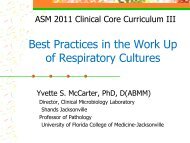Enlarged Perivascular Spaces in Lacunar Stroke
Enlarged Perivascular Spaces in Lacunar Stroke
Enlarged Perivascular Spaces in Lacunar Stroke
You also want an ePaper? Increase the reach of your titles
YUMPU automatically turns print PDFs into web optimized ePapers that Google loves.
<strong>Enlarged</strong> <strong>Perivascular</strong> <strong>Spaces</strong><br />
<strong>in</strong> <strong>Lacunar</strong> <strong>Stroke</strong><br />
The Secondary Prevention of Small Subcortical<br />
<strong>Stroke</strong> (SPS3) study<br />
H Ohba, LA Pearce, GM Potter, OR Benavente<br />
NIH/NINDS #U01 NS38529-04A1<br />
University of British Columbia,<br />
Vancouver, Canada<br />
www.cl<strong>in</strong>icaltrials.gov NCT00059306
Presenter Disclosure<br />
Information<br />
Hideki Ohba MD, PhD<br />
<strong>Enlarged</strong> <strong>Perivascular</strong> <strong>Spaces</strong> <strong>in</strong> <strong>Lacunar</strong> <strong>Stroke</strong> Patients.<br />
The Secondary Prevention of Small Subcortical <strong>Stroke</strong>d<br />
(SPS3) trial.<br />
FINANCIAL DISCLOSURE:<br />
None<br />
UNLABELED/UNAPPROVED USES DISCLOSURE:<br />
None<br />
2
SPS3<br />
<strong>Enlarged</strong> <strong>Perivascular</strong> <strong>Spaces</strong> (EPVS)<br />
• EPVS are commonly found on MRIs.<br />
• Reported associations with ag<strong>in</strong>g, hypertension,<br />
lacunar stroke, cognitive impairment, CADASIL and<br />
white matter disease, etc.<br />
• The pathophysiology and significance are still<br />
unclear.<br />
• However, EPVS may be a marker for cerebral small<br />
vessel disease
SPS3<br />
Secondary Prevention of Small<br />
Subcortical <strong>Stroke</strong> (SPS3) Study<br />
Randomized multicenter trial,<br />
Recent lacunar strokes verified by MRI<br />
No cortical stroke, cardioembolic source / carotid stenosis<br />
Recruitment completed <strong>in</strong> April 2011 with 3020 participants<br />
Randomized to 2 <strong>in</strong>terventions <strong>in</strong> a factorial design:<br />
1) Antiplatelet therapy:<br />
-aspir<strong>in</strong> 325 mg + placebo<br />
-aspir<strong>in</strong> 325 mg + clopidogrel 75 mg<br />
2) Target levels of blood pressure:<br />
-”usual” 130-149 mmHg systolic<br />
-”<strong>in</strong>tensive”
SPS3<br />
Aims<br />
To evaluate the association between stroke risk<br />
factors, cognitive function and MRI f<strong>in</strong>d<strong>in</strong>gs with<br />
EPVS <strong>in</strong> the SPS3 cohort
SPS3<br />
EPVS Def<strong>in</strong>ition and Rat<strong>in</strong>g<br />
• EPVS rated on T2-WI; basal ganglia and centrum<br />
semiovale were rated separately for left and right<br />
Small, sharply del<strong>in</strong>eated structures, 40<br />
MacLullich AM,. J Neurol Neurosurg Psychiatry. 2004;75:1519–1523
SPS3<br />
Score 1 = 1-10 EPVS<br />
EPVS Rat<strong>in</strong>g<br />
T2-WI <strong>in</strong> Basal ganglia (BG)<br />
Score 3 = 21-40 EPVS<br />
Score 2 = 11-20 EPVS<br />
Score 4 >40 EPVS
SPS3<br />
Score 1<br />
=1-10 EPVS<br />
EPVS Rat<strong>in</strong>g<br />
T2-WI <strong>in</strong> Centrum semiovale<br />
Score 2<br />
=11-20 EPVS<br />
Score 3<br />
=21-40 EPVS<br />
Score 4<br />
>40 EPVS
SPS3<br />
1632<br />
English speak<strong>in</strong>g participants from USA<br />
and Canadian sites<br />
Exclude: 203<br />
T2-WI not available.<br />
Cohort<br />
N:1172<br />
Included <strong>in</strong> the<br />
analysis<br />
Exclude: 251<br />
motion artifacts <strong>in</strong> one or<br />
more places
SPS3<br />
Results: Basel<strong>in</strong>e Characteristics I<br />
N= 1172<br />
Age <strong>in</strong> years, mean (sd) 62 (11)<br />
Male, % 57<br />
Diabetes mellitus, % 31<br />
Hypertension, % 79<br />
Ischemic heart disease, % 14<br />
Hyperlipidemia, % 57<br />
Prior <strong>Stroke</strong>, % 10<br />
CASI, median 91<br />
Cognitive assessment screen<strong>in</strong>g <strong>in</strong>strument (CASI)
SPS3<br />
Results: Basel<strong>in</strong>e Characteristics II<br />
eGFR per CKD-EPI equation, ml/m<strong>in</strong>/1.73m 2 , mean(sd)<br />
Age Related White Matter Changes (ARWMC)<br />
Multiple lacunar <strong>in</strong>farcts (5-15mm) on MRI<br />
N= 1172
%<br />
SPS3<br />
70<br />
60<br />
50<br />
40<br />
30<br />
20<br />
10<br />
0<br />
EPVS<br />
N= EPVS:<br />
of EPB<br />
Results: Basel<strong>in</strong>e EPVS Scores<br />
1<br />
2<br />
58<br />
31<br />
BG CS<br />
28<br />
Score = 0 Score = 1 Score = 2 Score = 3 Score = 4<br />
40<br />
p40)<br />
10<br />
22<br />
3<br />
7
SPS3<br />
Results: Basal Ganglia<br />
EPVS Number<br />
< 10 11-20 21+ p-value<br />
Age, mean 59 63 70 < 0.001<br />
Male, % 58 58 57 1.0<br />
Diabetes mellitus, % 34 31 22 0.01<br />
Hyperlipidemia, % 56 59 55 0.6<br />
Hypertension, % 75 84 86 < 0.001<br />
IHD, % 11 14 18 0.05<br />
Prior <strong>Stroke</strong>, % 8 12 13 0.05<br />
eGFR, mean 83 80 74 < 0.001
SPS3<br />
Results: Centrum Semiovale<br />
EPVS Number<br />
< 10 11-20 21+ p-value<br />
Age, mean 59 62 64 < 0.001<br />
Male, % 56 57 60 0.6<br />
Diabetes mellitus, % 35 30 30 0.2<br />
Hyperlipidemia, % 59 56 56 0.6<br />
Hypertension, % 76 78 83 0.05<br />
IHD, % 12 14 13 0.5<br />
Prior <strong>Stroke</strong>, % 11 9 11 0.7<br />
eGFR, mean 83 80 79 0.01
SPS3<br />
Results: Associations Between<br />
Number of EPVS and MRI F<strong>in</strong>d<strong>in</strong>gs<br />
Max Basal Ganglia EPVS Number<br />
ARWMC total, median 3 6 8 < 0.001<br />
Fazekas total, median 4 6 8 < 0.001<br />
Multiple <strong>in</strong>farcts, % 11 19 29 < 0.001<br />
Max Centrum Semiovale EPVS Number<br />
< 10 11-20 21+ p-value<br />
ARWMC total, median 3 4 5 < 0.001<br />
Fazekas total, median 4 5 6 < 0.001<br />
Multiple <strong>in</strong>farcts, % 12 14 21 0.003<br />
ARWMC: Age Related White Matter Changes<br />
Fazekas: Rat<strong>in</strong>g scale periventricular and white matter abnormality
SPS3<br />
High Number of EPVS (>11)<br />
Multivariate Analysis<br />
Odds Ratio 95% CI<br />
Basal Ganglia<br />
• Age per 10 year ↑ 1.9 1.7-2.1<br />
• Hypertension 1.7 1.2-2.3<br />
• Multiple <strong>in</strong>farcts 2.4 1.7-3.4<br />
Centrum Semiovale<br />
• Age per 10 year ↑ 1.5 1.3-1.6
SPS3<br />
Results: Cognitive Impairment<br />
Max BG EPVS Number Max CS EPVS Number<br />
< 10 11-20 21+ p < 10 11-20 21+ p<br />
N 680 333 159 367 471 334<br />
• z-score CASI,<br />
median<br />
• Mild cognitive<br />
impairment<br />
NCI<br />
MCI-a<br />
MCI-na<br />
MCI-md<br />
-0.25 -0.45 -0.34 0.2 -0.34 -0.34 -0.35 0.5<br />
54<br />
16<br />
13<br />
18<br />
55<br />
16<br />
11<br />
18<br />
54<br />
16<br />
18<br />
12<br />
CASI = Cognitive Abilities Screen<strong>in</strong>g Instrument<br />
MCI = mild cognitive impairment<br />
NCI: not cognitively impaired<br />
MCI-a: amnestic (memory impairment only)<br />
MCI-na: non amnestic (non-memory impairment only; may be perceptual-verbal process<strong>in</strong>g speed and/or executive function<strong>in</strong>g)<br />
MCI-md: multi-doma<strong>in</strong> (both memory and non-memory impairment)<br />
0.3<br />
52<br />
14<br />
14<br />
20<br />
55<br />
16<br />
13<br />
16<br />
56<br />
17<br />
13<br />
15<br />
0.5
SPS3<br />
Conclusions<br />
In this well-def<strong>in</strong>ed large cohort of lacunar stroke<br />
patients, EPVS <strong>in</strong> BG were <strong>in</strong>dependently associated<br />
with age, hypertension and multiple <strong>in</strong>farcts.<br />
EPVS were not associated with cognitive impairment<br />
EPVS share similar risk factors with lacunar stroke<br />
and may be a marker for small vessel disease.
SPS3<br />
Thank You!<br />
Our s<strong>in</strong>cere thanks to our SPS3 colleagues,<br />
patients and NINDS/NIH for contribut<strong>in</strong>g to<br />
this study<br />
Study Progress<br />
Antiplatelet Trial Results: February 3 rd 2012<br />
Blood Pressure Trial completion: April 2012<br />
Results Anticipated: Late 2012


